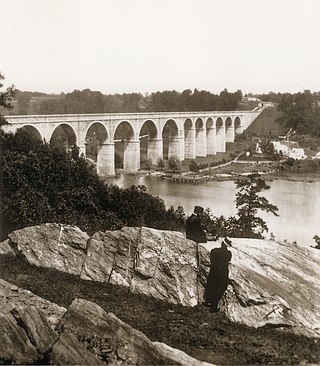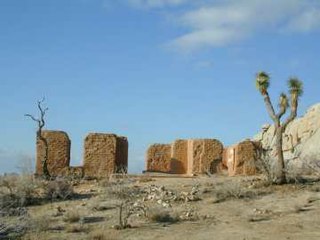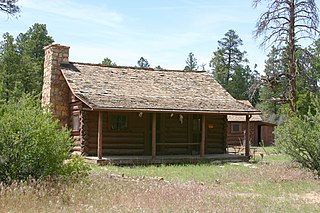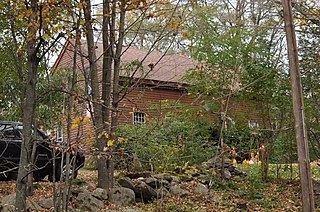
The Croton Aqueduct or Old Croton Aqueduct was a large and complex water distribution system constructed for New York City between 1837 and 1842. The great aqueducts, which were among the first in the United States, carried water by gravity 41 miles (66 km) from the Croton River in Westchester County to reservoirs in Manhattan. It was built because local water resources had become polluted and inadequate for the growing population of the city. Although the aqueduct was largely superseded by the New Croton Aqueduct, which was built in 1890, the Old Croton Aqueduct remained in service until 1955.
The Rio Grande Ranch Headquarters Historic District is a historic one-story residence located 3 miles (4.8 km) east of Okay in Wagoner County, Oklahoma. The site was listed on the National Register of Historic Places September 9, 1992. The site's Period of Significance is 1910 to 1935, and it qualified for listing under NRHP criteria A and C.

The Ryan House and Lost Horse Well are historic ruins in Joshua Tree National Park, California, United States. It was established by the family of J.D. Ryan, the later developers of the Lost Horse Mine, which became the most profitable mine in the area. The Lost Horse Well at the Ryan Ranch supplied water to the Lost Horse Mine, 3 miles (5 km) south and 750 feet (230 m), by pipeline.

Howell Trevor Pugh, known as H. T. Pugh, was a stonemason who was trained in Wales and worked primarily in Jerome, Idaho. His high quality work popularized the use of lava rock in the Jerome area, eventually including for fine residences in town. More than 20 of his works are preserved and are listed on the National Register of Historic Places.

The James Bothwell Water Tank House is a water tank house located on a farm 3.25 miles (5.23 km) north of Jerome, Idaho. The building was constructed circa 1926 for James Bothwell, a local lawyer and farmland investor. Bothwell built the tank house and a well on the property to help provide water for the farm. The building was constructed with lava rock by stonemason John Gott, who was trained in Germany. It is one of two original rock water tank houses remaining in Jerome and Lincoln Counties.
The Hugh and Susie Goff House is a historic house located in Jerome, Idaho.
The Jay Van Hook Potato Cellar is a historic potato house located in Jerome, Idaho.

The Arnold Stevens House is a historic house located in Jerome, Idaho. It is part of the Lava Rock Structures in South Central Idaho Thematic Resource and was listed on the National Register of Historic Places on September 8, 1983.

The Greer and Jennie Quay House is a historic house located in Jerome, Idaho.

The Marion and Julia Kelley House is a historic house located at 450 4th Street East in Hazelton, Idaho.

The Denton J. Paul Water Tank near Dietrich, Idaho, United States, was built in c.1918, perhaps by stonemason Ignacio Berriochoa and his helper Julian Pagoaga; Berriochoa lived about three miles away. It was listed on the National Register of Historic Places in 1983.
William Lindsey Darrah was a sheep rancher and stonemason in Shoshone, Idaho known for his construction of lava rock water tanks from the 1910s to 1920s. He built water tanks ranging from approximately eight to 30 feet high and from 12 to 25 feet in diameter. His tanks were typically built with a stone foundation several feet into the ground. The walls were approximately three feet wide and built out of lava stones and lime mortar. Darrah's tanks were typically accompanied by one-story pump houses
The Darrah House and Water Tank House, near Shoshone, Idaho, were built in 1913 by sheep rancher and stonemason Bill Darrah. They was listed on the National Register of Historic Places in 1983. The listing included two contributing buildings on 5 acres (2.0 ha).
The Ben Darrah Water Tank and Well House near Shoshone, Idaho, United States, were built in c. 1916 by stonemason Bill Darrah. They were listed on the National Register of Historic Places in 1983; the listing included two contributing buildings on 1.3 acres (0.53 ha).
The J. W. and Rachel Newman House and Bunkhouse near Jerome, Idaho was built in the 1920s by sheep rancher and stonemason Bill Darrah. It was listed on the National Register of Historic Places in 1983. The listing included two contributing buildings.
The Arthur D. Silva Water Tank near Shoshone, Idaho, United States, was built in 1910. It was a work of sheep rancher and stonemason Bill Darrah and of stonemasons Pete Duffy & Sons. It was listed on the National Register of Historic Places in 1983.

The Hull Cabin was built in the late 1880s near the South Rim of the Grand Canyon by settler William Hull. The Hull family arrived in the area in 1880 and established a ranch in the area, raising sheep and building the Hull Tank, a large earth-banked reservoir for their stock. The Hulls branched out into prospecting and were among the first to take in tourists heading to the Grand Canyon.

The Janicke House is a historic house on Goshen Center Road in Goshen, New Hampshire. Built about 1830, it is one of a regionally distinctive cluster of plank-frame houses built in the 19th century. The house was listed on the National Register of Historic Places in 1985.
The Ben Laughlin Water Tank House-Garage, near Jerome, Idaho, was built in 1927. It was listed on the National Register of Historic Places in 1983.

The William Weigle House and Water Tank, near Jerome, Idaho, is a lava rock structure built in 1919. It was listed on the National Register of Historic Places in 1983.













